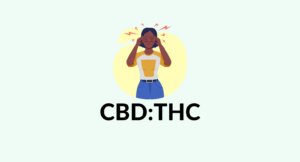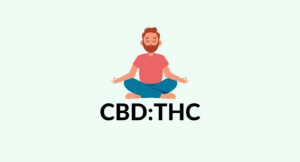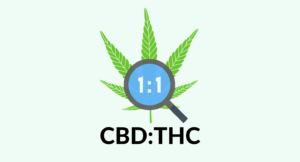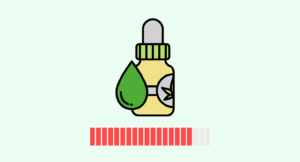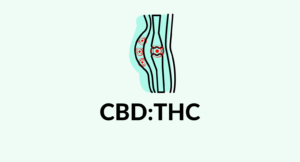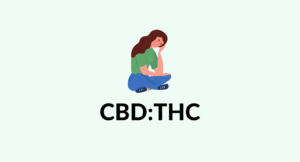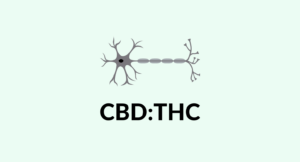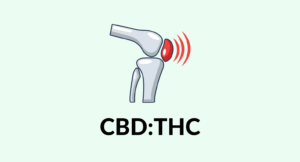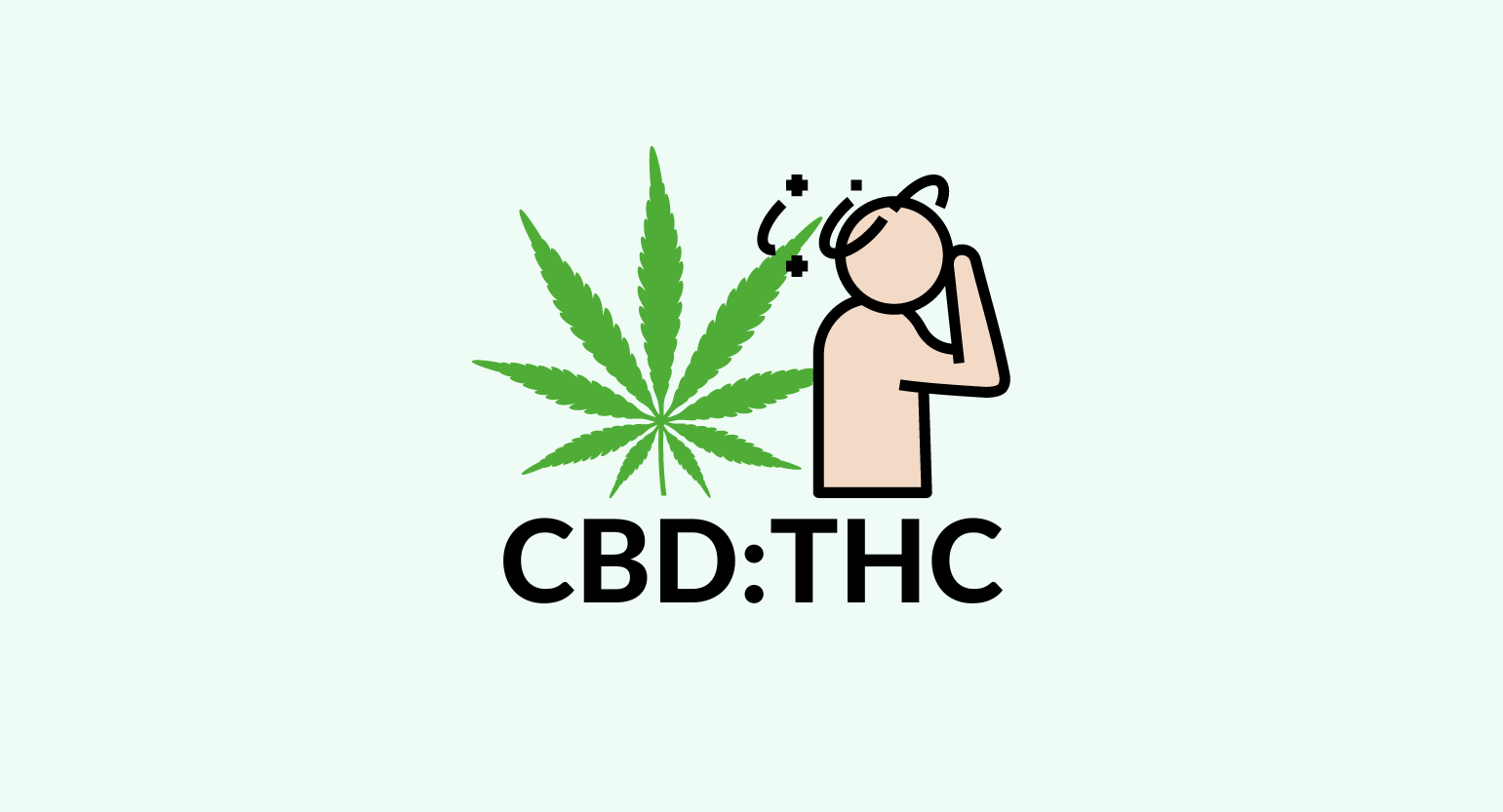
Evidence based
Best CBD:THC Ratio for Nausea
Nausea and vomiting can occur for so many reasons. Cannabinoids like CBD and THC can relieve nausea by interacting with the endocannabinoid system (ECS).
The cannabinoids cannabidiol (CBD), and delta 9 tetrahydrocannabinol (THC), work together to offer relief from nausea. From cancer patients to individuals who take nausea-inducing medications, there are millions of people in need of effective nausea treatments.
Nausea can keep you from eating and getting the nutrients you need, which is all the more important if you’re battling another disease. While over-the-counter and prescription nausea treatments can work, they’re often less effective than needed or come with many negative side effects. That’s where CBD and THC come in.
When taken together, these compounds offer powerful nausea relief in many patients. The best CBD:THC ratio for nausea is 1:1+, with one part CBD to one or more parts THC.
Here’s everything you need to know about the best CBD:THC ratio for nausea.
What Is Nausea?
Nausea and vomiting can occur for so many reasons. The medulla in the brain contains an area called the vomiting center, which is where the most activity that causes nausea occurs [1].
If you’re a cancer patient, for example, you might be in the middle of chemotherapy treatment. Chemotherapy does massive damage to the body in an effort to kill cancerous tumors and stop further growth.
As a result, the body goes into a defensive mode during chemotherapy. Your brain releases chemicals that make you sick in an effort to dispel the chemo, while your stomach reacts to the harshness of chemo on the digestive tract.
All of this means a lot of untenable nausea and potential vomiting that makes it hard to eat.
For people who aren’t undergoing chemotherapy, nausea could occur for any number of reasons.
One important thing to understand about nausea is that it doesn’t always come from a gastrointestinal issue. Whether it’s your digestive tract reacting poorly to medication, anxiety that sends your body into fight-or-flight mode, or motion sickness from vertigo, nausea is your body’s reaction to infiltration of some sort.
Feeling nauseated on occasion is a normal part of life, and it’s a good idea to listen to your body when you feel like getting sick. It might mean the food you’re eating is bad or that you need something else like water or fiber.
That said, when nausea becomes consistent, it can be massively debilitating. Even for individuals whose nausea rarely escalates into vomiting, the experience can reduce their quality of life.
Chronic nausea causes a host of issues when it comes to eating, making it difficult to keep food down, eat food you enjoy, or put food in your mouth at all.
Common Nausea Medications
Common nausea medications range from holistic remedies like ginger tea all the way to prescriptions. The medications used to treat nausea caused by other medications or by motion sickness are called antiemetic drugs.
Often, these drugs don’t do the job well enough because of one of these factors:
- Too many side effects
- They don’t suppress delayed nausea
- They don’t suppress anticipatory nausea
When it comes to over-the-counter and holistic options, most nausea medications seek to relieve gastrointestinal distress. However, many patients afflicted by nausea don’t have gastrointestinal issues in the first place.
Some people feel nauseated during panic attacks, for example. Taking something like Pepto Bismol probably wouldn’t help for that type of nausea since the ingredients target the stomach.
For chemo patients and chronic nausea sufferers, it’s usually a combination of several anti-nausea medications — each of them rife with side effects — that work well enough to let the patient eat some food.
Common anti-nausea medications include aprepitant, dexamethasone, lorazepam, and scopolamine.
Some common side effects include:
- Dry mouth
- Constipation
- Confusion
- Blurred vision
- Anxiety
- Sexual dysfunction
- Headache
- Depression
- Memory impairment
- Fatigue
Many nausea medications seek to treat the cause of potential vomiting rather than the sensation of nausea itself. That’s where cannabinoids come in.
Common Cannabis Medications for Nausea
Luckily for chemo patients, some cannabis-based medications have been developed for antiemetic use.
Dronabinol is a synthetic delta 9 THC medication commonly used for chemo patients. Nabilone contains synthetic delta 9 THC and is prescribed for several other uses like anxiety and pain.
Nabilone was created specifically for anti-nausea purposes in chemotherapy patients.
Both of these medications are legal in all states where medical marijuana is legal. However, you don’t need a prescription to use cannabis for nausea.

Why Cannabinoids Work for Nausea
As discussed, most medications that work to treat nausea are antiemetic drugs, which means they attempt to treat the source of nausea as opposed to nausea itself.
Cannabis, on the other hand, has anti-nausea effects as well as antiemetic effects.
Cannabinoids work for nausea because they interact with the endocannabinoid system’s CB1 receptor, which lives in the brain’s vomiting center [1].
Cannabidiol, or CBD, and delta 9 tetrahydrocannabinol, or THC, act on the CB1 receptor. CB1 agonism has been shown to suppress vomiting in humans and animals (whereas CB1 antagonism causes vomiting) [2].
It’s believed that CBD also has anti-nausea effects because it indirectly activates the 5-HT3 receptors, which release anti-nausea chemicals into the brain.
This is the same area of the brain targeted by some common drugs that cause nausea, but instead of antagonizing these receptors, CBD interacts with them indirectly. The result is reduced vomiting as well as reduced nausea.
Cannabis for Delayed & Anticipatory Nausea
CBD is also thought to work better for delayed and anticipatory nausea.
Delayed nausea refers to nausea that occurs at least 24 hours after the nauseating event, while anticipatory nausea refers to conditioned nausea that occurs due to psychological anticipation of nausea.
THC is also used to treat acute, delayed, and anticipatory nausea in children. With delta 8 THC, which causes lessened psychoactive effects compared to delta 9 THC, few children in a human trial showed negative side effects, but the efficacy was better than other options [2].
Using CBD and THC for Nausea
While CBD and THC are effective on their own in treating nausea, they’re even better when paired together.
There is a lack of studies addressing the specific effectiveness of CBD:THC ratio products for use in reducing nausea. However, user reports and limited studies show promise.
The vast existing studies proving the effectiveness of CBD and THC on their own shouldn’t be ignored either, especially considering the entourage effect. The entourage effect is the principle that in almost every case, cannabinoids are more effective when paired with other cannabinoids.
Most patients using CBD and THC to treat nausea, especially those undergoing chemotherapy, prefer to smoke cannabis. While dronabinol and nabilone are available, they come in pill form, and many patients are so nauseated that they’d rather not put a pill in their mouths.
There’s also the option of Sativex, which is a 1:1 CBD:THC prescription medication administered in the form of a nasal spray.
There are no studies on the effectiveness of Sativex or other nasal sprays for nausea specifically. However, nasal sprays bypass the digestive process, so they may have higher bioavailability than oral or smoked cannabis.
The Best CBD:THC Ratio for Nausea
The best CBD:THC ratio for nausea is 1:1+. That means one part CBD to at least one part THC.
It’s recommended that you keep your CBD dose under 10 mg since some patients report opposite effects when they take too much CBD. CBD can reduce appetite when taken in large doses, which is the last thing a chronically nauseated person wants to deal with.
When it comes to the THC, however, you can take as much as you need to take the edge off of your nausea. The CBD will have a slight antipsychotic effect, which can help with any paranoia or euphoria you feel from the THC.
Another reason not to shy away from THC is its appetite stimulation effects. THC is a powerful appetite stimulant, which is an incredible relief for patients who haven’t been able to keep food down or who get nauseated at the sight and smell of food.
You can find CBD:THC ratio products in the form of edibles, tinctures, pre-rolled joints, and more. You can also find it in good old-fashioned weed, since most weed contains some CBD and some THC.
As we mentioned, many patients prefer to smoke weed when they’re attempting to treat nausea. That’s due to the instant relief, which can’t be said for gummies or tinctures, and the ability to take the drug without putting something in your mouth. That said, a tincture can easily be mixed with water or other beverages.

Other Homeopathic Ways to Lessen Nausea
If you aren’t a cancer patient, you might be looking for some less intense ways to cure nausea. Of course, CBD and THC work no matter how intense or frequent your nausea is, so they’re always available.
You can treat nausea from medication, nerves, or motion sickness with CBD and THC, but the following remedies might help, too.
1. Eat Ginger & Peppermint
Ginger and peppermint are two inexpensive, easy-to-use treatments for nausea.
Ginger works to calm the stomach by regulating digestive function, so if you have nausea related to an upset stomach, this could work well. It’s also good for motion sickness because it helps regulate blood pressure, which is one cause of seasickness [3].
You can eat ginger, put ginger extract in tea or water, or cook it into food.
2. Eat Only Bland Foods
It’s best to stick with bland, inoffensive foods when you’re feeling nauseated. Even if food isn’t the cause of your nausea, an acidic food in the stomach or a strong smell in the nostrils could make nausea turn into vomiting.
In the interest of protecting your gut, eat bland foods when you have nausea. Plain rice, oatmeal, and bread are good places to start. The trick is to avoid foods that are highly acidic, like fruit and spice, as well as too fatty, like meat or oils.
With that in mind, don’t go overboard on the ginger since it is acidic.
3. Use Peppermint Aromatherapy
Peppermint is most effective for nausea as an essential oil, which shouldn’t be consumed orally. Peppermint can be used as an aromatherapy treatment for nausea, and it’s proven to work even when used in isolation (without other anti-nausea drugs) [4]. Use it in a diffuser or simply place some on your wrists or below your nose.

Conclusion: What’s the Best CBD:THC Ratio for Nausea?
The best CBD:THC ratio for nausea is 1:1+, with one part CBD to one or more parts THC. Too much CBD might cause appetite suppression, whereas THC may stimulate the appetite. It’s best to combine CBD with THC so you can get the antiemetic and anti-nausea effects of both compounds, which interact with the vomiting center to limit feelings of nausea.
Cannabinoids are helpful in reducing nausea in anyone from chemotherapy patients to people with motion sickness or vertigo. It can be combined with ginger, bland foods, or peppermint aromatherapy to help further reduce nausea and the chance of vomiting.
Sources
- Singh, P., Yoon, S. S., & Kuo, B. (2016). Nausea: a review of pathophysiology and therapeutics. Therapeutic advances in gastroenterology, 9(1), 98-112.
- Parker, L. A., Rock, E. M., & Limebeer, C. L. (2011). Regulation of nausea and vomiting by cannabinoids. British journal of pharmacology, 163(7), 1411-1422.
- Lete, I., & Alluέ, J. (2016). The effectiveness of ginger in the prevention of nausea and vomiting during pregnancy and chemotherapy. Integrative medicine insights, 11, IMI-S36273.
- Mohr, C., Jensen, C., Padden, N., Besel, J. M., & Brant, J. M. (2021). Peppermint Essential Oil for Nausea and Vomiting in Hospitalized Patients: Incorporating Holistic Patient Decision Making Into the Research Design. Journal of Holistic Nursing, 39(2), 126-134.
